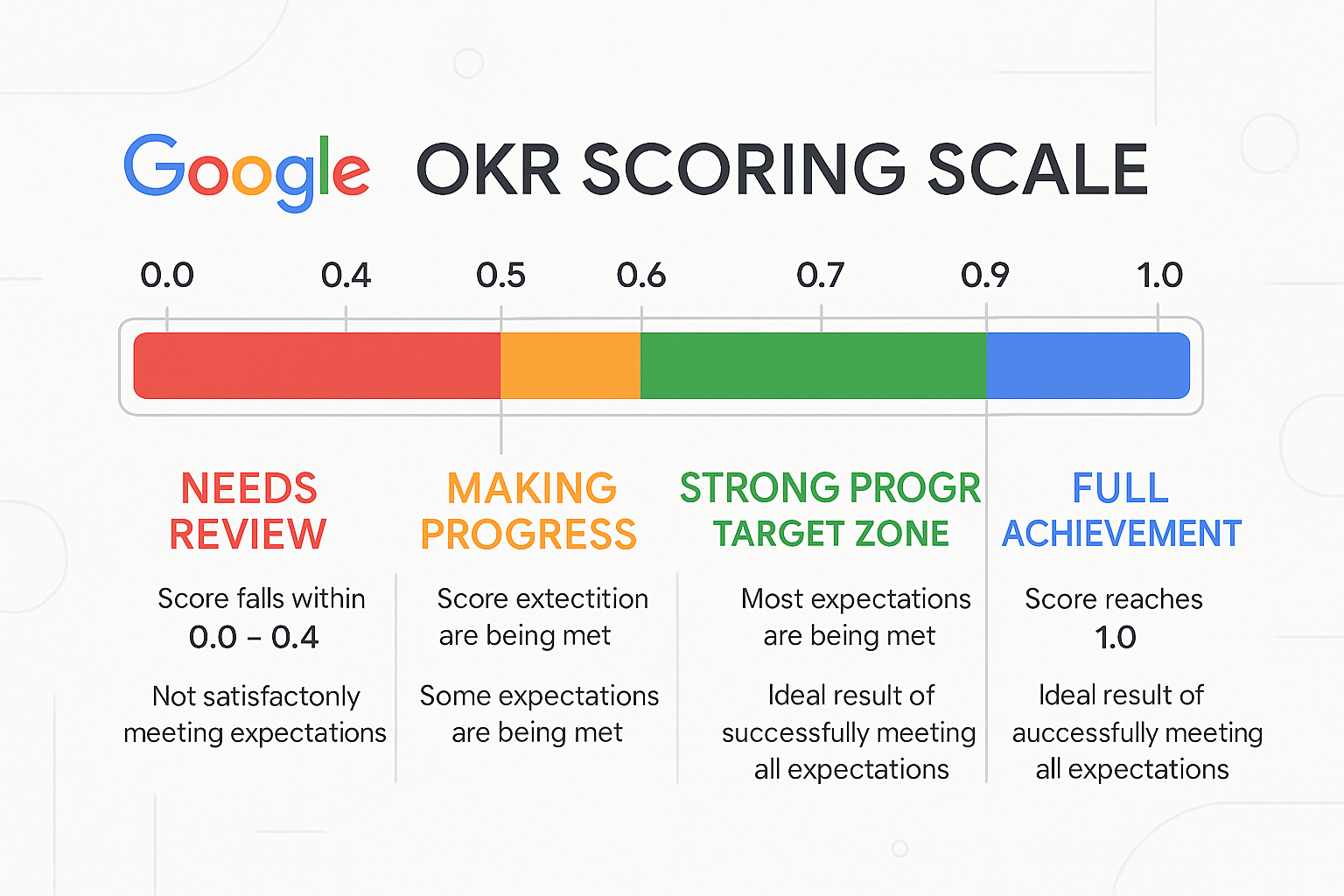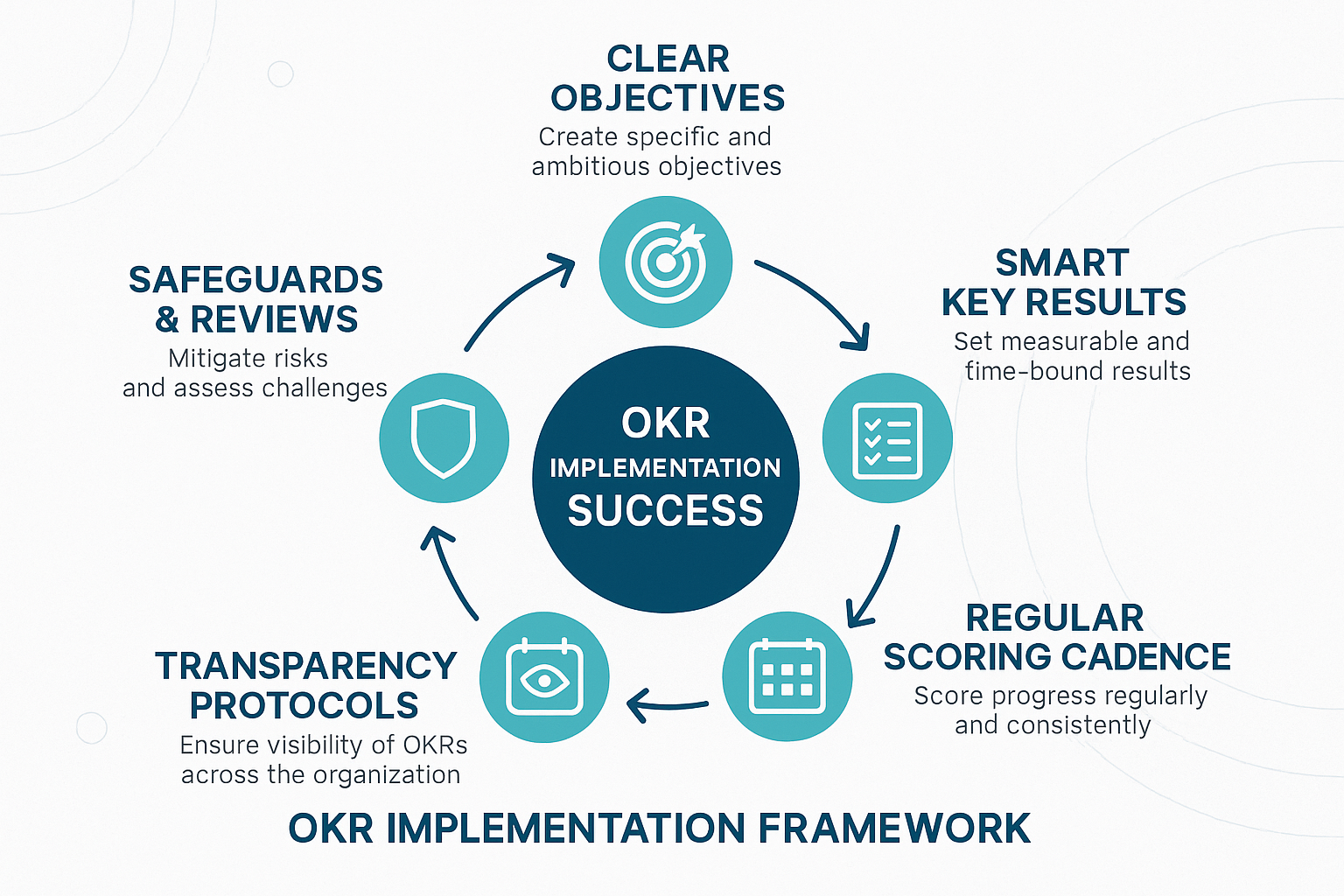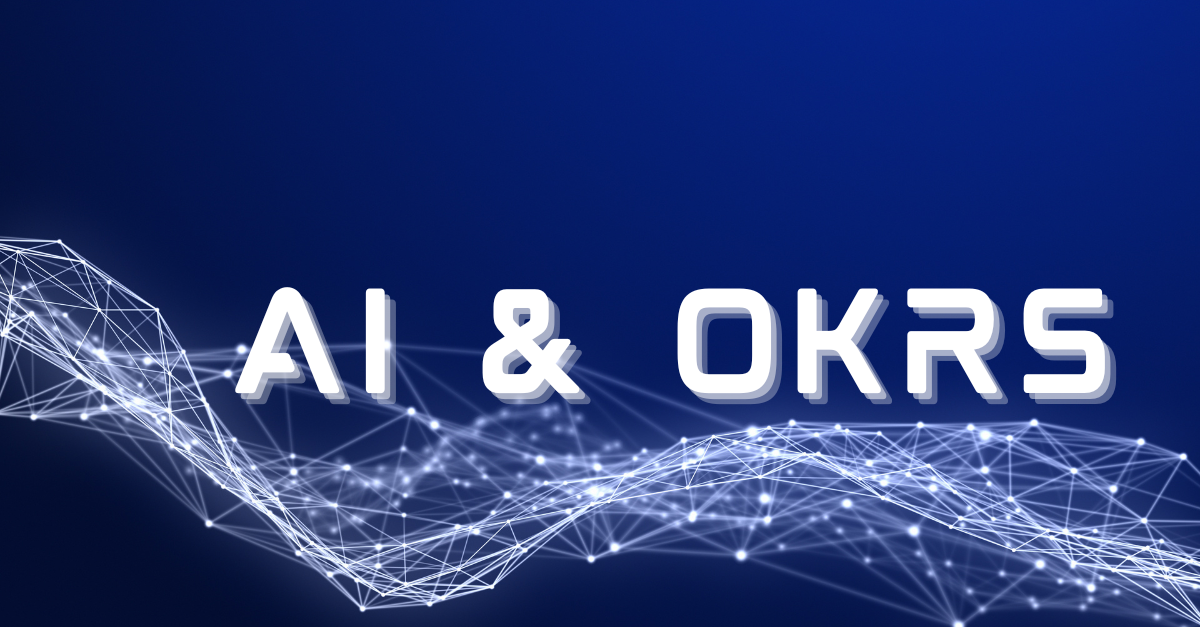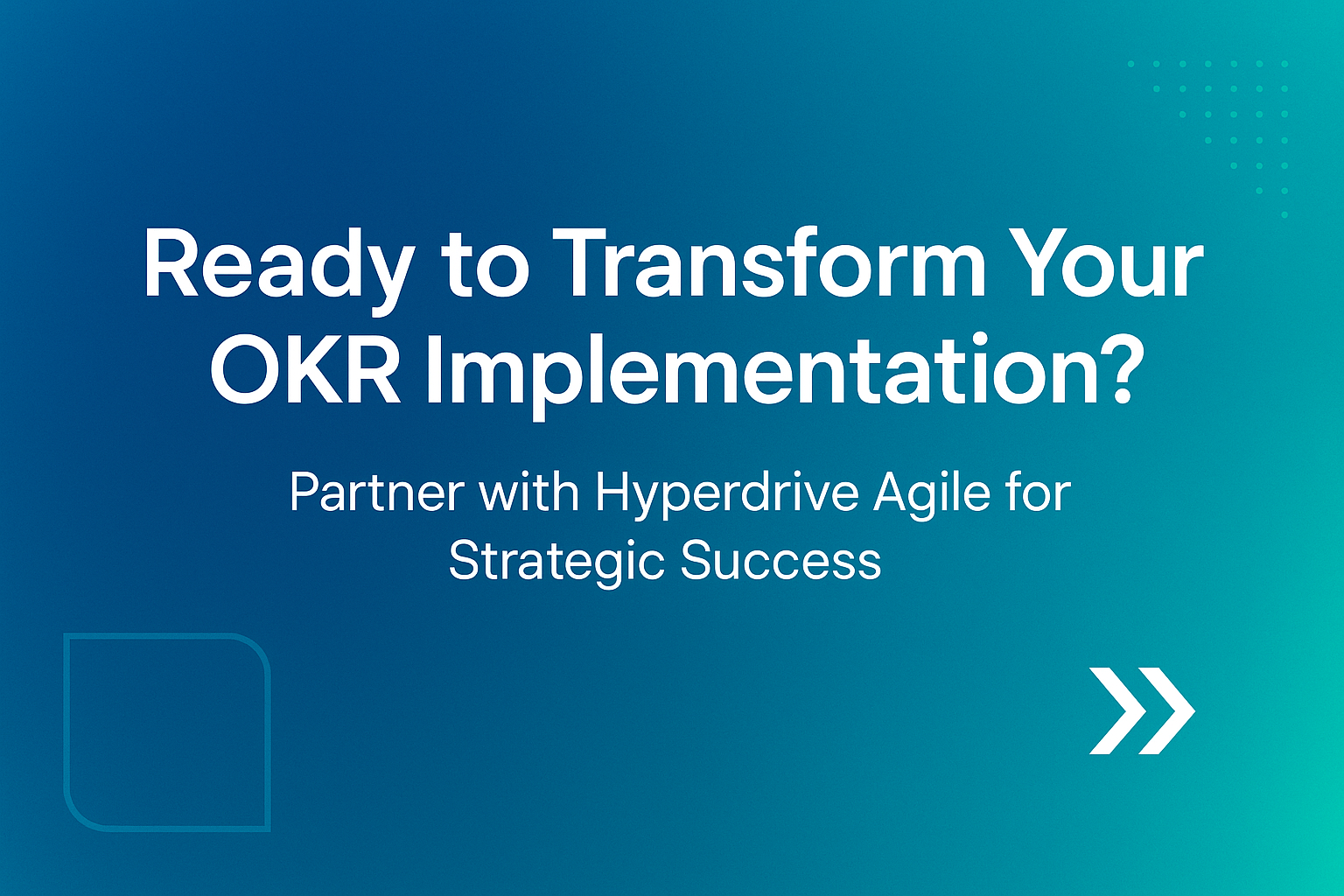Advanced OKR Scoring: Beyond Agile Metrics
The disconnect between strategy and execution is a common headache for leaders across all industries. You’ve likely experienced this frustration firsthand—watching your agile teams dutifully track velocity and burndown charts while somehow missing the strategic outcomes that actually move your business forward.
When Netflix transformed from a DVD service to a streaming giant, they didn’t rely on sprint velocity or story points to measure progress toward their ambitious objectives. Instead, they implemented sophisticated OKR scoring methodologies that captured the nuanced reality of strategic transformation, measuring not just what teams completed but how effectively they moved the business forward.
If you’re finding yourself trapped in a measurement paradox where your teams appear busy and productive on paper while missing critical business outcomes, you’re not alone. Advanced OKR scoring represents the bridge between operational efficiency and strategic impact—a fundamental shift from activity-based measurement to outcome-driven evaluation that transforms how your organization achieves its most important objectives.
Key Takeaways
- Advanced OKR scoring shifts your focus from activity to outcomes by measuring strategic objective achievement rather than task completion
- Confidence scoring and weighted prioritization enable you to proactively manage strategy by capturing your team’s assessment of achievement likelihood
- The sufficiency test prevents measurement blind spots by ensuring that achieving 100% completion on all key results will definitely accomplish your parent objective
- Transparency and multi-dimensional scoring drive organizational alignment through clear progress visibility across your teams
- Implementation safeguards prevent gaming and score inflation through regular strategic impact audits and peer review processes
Why Traditional Agile Metrics Miss Strategic Context
Agile methodologies revolutionized software development by focusing teams on iterative progress and customer feedback. However, the metrics that excel at tracking development work, velocity, story points, and cycle time, struggle to capture the strategic dimensions that executives need for informed decision-making.
Consider a product team that consistently delivers 40 story points per sprint with excellent burndown chart adherence. These metrics suggest high performance, but they reveal nothing about whether the team is building features that drive user engagement, reduce churn, or support revenue growth. The disconnect between operational efficiency and strategic impact creates blind spots that can persist for quarters before leadership recognizes the misalignment.
The fundamental limitation lies in the measurement scope. Agile metrics excel at answering “are we delivering on schedule?” but provide limited insight into “are we delivering the right outcomes?” This gap becomes particularly problematic in enterprise environments where multiple teams must coordinate toward shared strategic objectives that extend beyond individual product releases or development cycles.
“Traditional agile metrics measure the speed of execution, but advanced OKR scoring measures the quality of outcomes. The difference determines whether organizations achieve transformation or just stay busy.” , Strategic Transformation Expert
Core Components of Advanced OKR Scoring
Advanced OKR scoring systems incorporate multiple dimensions to create comprehensive performance pictures for your organization. Grading OKRs is a key part of these systems, allowing organizations to evaluate progress using various methods rather than simple pass/fail metrics. Unlike binary pass/fail metrics, these frameworks recognize that meaningful objectives rarely achieve perfect completion, and partial progress often contains valuable insights for strategic adjustment. The OKR score is typically calculated as an aggregate of individual key result scores, providing a quantifiable measure of overall achievement at the end of an OKR cycle.
Confidence Scoring and Predictive Analytics
Modern OKR platforms integrate confidence scoring to capture your team’s assessment of achievement likelihood. This forward-looking metric helps you identify potential roadblocks before they impact delivery, enabling proactive resource allocation and strategic pivots.
Confidence scoring typically operates on a percentage scale where your teams regularly assess their likelihood of achieving each key result. A key result tracking “increase customer retention to 85%” might show 70% confidence at quarter start, declining to 45% confidence after discovering technical challenges, then recovering to 80% confidence following your resource reallocation.
| Confidence Level | Strategic Action | Leadership Response |
|---|---|---|
| 90-100% | Monitor and maintain | Celebrate and scale success patterns |
| 70-89% | Continue with vigilance | Provide support and remove obstacles |
| 50-69% | Investigate and adjust | Consider resource reallocation |
| Below 50% | Reassess or pivot | Fundamental strategy review required |
Weighted Scoring for Strategic Prioritization
Not all key results carry equal strategic importance for your organization. Advanced scoring systems incorporate weighting mechanisms that reflect the relative value of different outcomes, ensuring that your overall objective scores accurately represent strategic progress rather than simple completion averages.
Sufficiency-Based Evaluation
Perhaps the most crucial advancement in OKR scoring involves evaluating whether your key results are collectively sufficient to achieve their parent objective. This assessment goes beyond individual KR completion to examine strategic coherence and outcome adequacy.
The sufficiency test asks a simple but powerful question: if your team achieves 100% completion on all key results, will you definitely accomplish the objective? When the answer is no, your OKR structure requires refinement before scoring can provide meaningful strategic insight.
Real-World Implementation Frameworks
Leading organizations have developed sophisticated approaches to advanced OKR scoring that balance analytical rigor with practical usability. These implementations demonstrate how theoretical frameworks translate into operational excellence for your organization.
Google’s 0-1 Transparency Model
Google introduced a strict 0.0-1.0 OKR scoring scale where 1.0 means full achievement and 0.7-0.9 signals strong progress toward an intentionally ambitious target. Scores below 0.4 triggered root-cause reviews and support interventions. A unified tracking platform surfaced scores company-wide to maintain ambition while spotlighting under-resourced key results.
The transparency aspect proved as important as the scoring methodology itself. By making scores visible across the organization, Google cultivated a culture where teams consistently set aspirational OKRs with appropriate difficulty ratings. This approach can transform how your teams approach goal-setting and accountability.

Enterprise Multi-Dimensional Scoring
Large enterprises often require scoring systems that accommodate complex organizational structures and diverse strategic priorities. These systems typically incorporate multiple scoring dimensions: completion percentage, strategic impact weighting, cross-functional dependency tracking, and risk-adjusted confidence intervals.
Multi-dimensional scoring enables you to understand not just what percentage of objectives your teams achieved, but how achievement patterns align with your strategic priorities, resource allocation effectiveness, and organizational capability development.
Best Practices for OKR Implementation
Driving transformational OKR success in your organization demands strategic precision and unwavering commitment to performance excellence. Here’s how forward-thinking organizations accelerate measurable business outcomes through their OKR implementation:
- Architect crystal-clear, measurable objectives: Every objective must deliver a specific, actionable direction that directly fuels your strategic business transformation, creating unstoppable momentum toward your vision.
- Engineer SMART key results that drive performance: Your key results become the performance engines—Specific, Measurable, Achievable, Relevant, and Time-bound frameworks that provide absolute clarity on what winning looks like for your teams.
- Establish regular scoring cadence: Weekly score updates with monthly executive reviews capture changing conditions while avoiding excessive administrative overhead that could burden your teams.
- Implement transparency protocols: Share scores across your teams to drive collaborative problem-solving and maintain accountability throughout your organization.
- Separate scoring from compensation: Prevent gaming by ensuring your OKR scores inform development conversations rather than directly impacting compensation decisions.

Common Pitfalls and Implementation Safeguards
Even sophisticated scoring systems can fail when you neglect fundamental implementation principles. The most common pitfalls involve score inflation, insufficient key result design, and measurement gaming that undermines strategic value.
Score inflation occurs when your teams consistently achieve high completion rates on objectives that don’t drive meaningful business outcomes. This pattern suggests either insufficiently ambitious goal-setting or poorly designed key results that measure activity rather than impact.
Insufficient key result design remains the most frequent implementation challenge we see. Teams often create key results that are individually measurable but collectively insufficient to guarantee objective achievement. Your effective key results must pass the sufficiency test: achieving 100% completion on all KRs should definitely accomplish the parent objective.
Gaming prevention requires careful attention to incentive alignment. When compensation or performance reviews tie directly to OKR scores, your teams may optimize for measurement rather than strategic outcomes. Effective safeguards include regular score auditing, peer review processes, and leadership evaluation of strategic impact beyond numeric achievement.
Future Outlook: AI and Predictive Analytics
The next evolution in OKR scoring involves artificial intelligence and machine learning integration that transforms reactive measurement into proactive strategic guidance for your organization. AI-powered platforms analyze historical achievement patterns, external market conditions, and internal capability constraints to provide sophisticated probability assessments and strategic recommendations.
Predictive analytics capabilities enable scenario planning where you can model different resource allocation decisions and strategic pivot options. Natural language processing technologies are beginning to analyze qualitative feedback and progress narratives to identify subtle patterns in team confidence, external constraint impacts, and strategic assumption validity.
Frequently Asked Questions
How do advanced OKR scoring methods differ from traditional project management metrics?
Advanced OKR scoring focuses on strategic outcome achievement rather than task completion or schedule adherence. While project metrics track delivery efficiency, OKR scoring evaluates strategic impact and objective progress quality—helping you understand whether your teams are building the right things, not just building things right.
Can small organizations benefit from sophisticated OKR scoring?
Absolutely. Small organizations often see proportionally greater benefits from advanced scoring because limited resources make strategic focus even more critical. Simple confidence scoring and weighted prioritization can dramatically improve your resource allocation effectiveness and competitive positioning.
How frequently should we update our OKR scores?
Most successful implementations use weekly score updates with monthly executive reviews. Confidence assessments benefit from bi-weekly evaluation to capture changing conditions while avoiding excessive administrative overhead that could distract your teams from execution.
What safeguards prevent teams from gaming advanced scoring systems?
Effective safeguards include peer review processes, regular strategic impact audits, leadership evaluation of business outcome correlation, and separation of scoring from compensation decisions. The Andy Grove method, which uses a binary ‘yes’ or ‘no’ approach to determine if objectives are achieved, can also serve as a straightforward scoring safeguard. Transparency and education about gaming risks also help maintain system integrity.
What safeguards prevent teams from gaming advanced scoring systems?
Effective safeguards include peer review processes, regular strategic impact audits, leadership evaluation of business outcome correlation, and separation of scoring from compensation decisions. Transparency and education about gaming risks also help maintain system integrity across your organization.
Transforming Measurement Into Strategic Advantage
The evolution from basic agile metrics to advanced OKR scoring represents more than a measurement upgrade—it reflects a fundamental shift toward strategic clarity and outcome accountability that can transform your competitive position. Your organization’s success with these sophisticated frameworks depends on more than platform selection or scoring methodology adoption. You need a deep understanding of OKR design principles, practical experience with scoring implementation, and ongoing capability development to maximize framework value. The combination of methodological expertise and hands-on implementation skills separates organizations that achieve transformation from those that simply implement new measurement systems.
We’ve seen this transformation happen countless times. When you master advanced OKR scoring, you gain decisive advantages in strategic execution, resource optimization, and competitive positioning. Your teams become more aligned, your leadership gains clearer visibility into progress, and your organization develops the agility to pivot quickly when market conditions change.
The path forward involves systematic capability building, platform optimization, and cultural transformation around outcome-focused measurement. Together, we can bridge the gap between your strategic vision and operational execution, creating the alignment and accountability that drives sustainable business growth.
Ready to transform how your organization measures and achieves its most important objectives? Discover our OKR certification courses and let’s explore how advanced OKR scoring can unlock your team’s potential and accelerate your strategic success.
Questions? We Can Help.
When you’re ready to move beyond piecemeal resources and take your Agile skills or transformation efforts to the next level, get personalized support from the world’s leaders in agility.

